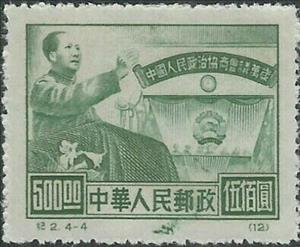Stamp: Mao Tse-Tung (Original) (China, People's Republic 1950)
Mao Tse-Tung (Original) (China, People's Republic 1950)
01 February (China, People's Republic ) within release Chinese People's Political Consultative Conference goes into circulation Stamp Mao Tse-Tung (Original) face value 500 Chinese dollar
| Stamp Mao Tse-Tung (Original) in catalogues | |
|---|---|
| Michel: | Mi: CN 11I |
| Stamp Number: | Sn: CN 11 |
| Yvert et Tellier: | Yt: CN 830 |
| Stanley Gibbons: | Sg: CN 1411 |
Stamp is horizontal format.
Reprints are much more common than originals. They were prepared and put on sale by the Philatelic Agency in order to supply stocks of exhausted issues for collectors and were not valid for postal use. Check the thin lines, they are mostly missing in the reprints. The color of the reprints is also often not deep as well.Also in the issue Chinese People's Political Consultative Conference:
- Stamp - Conference Hall, Beijing (Original) face value 50;
- Stamp - Conference Hall, Beijing (Original) face value 100;
- Stamp - Mao Tse-Tung (Original) face value 300;
- Stamp - Mao Tse-Tung (Original) face value 500;
Stamp Mao Tse-Tung (Original) it reflects the thematic directions:
A conference is a meeting, often lasting a few days, which is organized on a particular subject, or to bring together people who have a common interest. Conferences can be used as a form of group decision-making, although discussion, not always decisions, is the primary purpose of conferences. The term derives from the word confer.
Famous People refers to the fame and public attention accorded by the mass media to individuals or groups or, occasionally, animals, but is usually applied to the persons or groups of people (celebrity couples, families, etc.) themselves who receive such a status of fame and attention. Celebrity status is often associated with wealth (commonly referred to as fame and fortune), while fame often provides opportunities to make money.
A head of state (or chief of state) is the public persona that officially represents the national unity and legitimacy of a sovereign state. In some countries, the head of state is a ceremonial figurehead with limited or no executive power, while in others, the head of state is also the head of government. In countries with parliamentary governments, the head of state is typically a ceremonial figurehead that does not actually guide day-to-day government activities and may not be empowered to exercise any kind of secular political authority (e.g., Queen Elizabeth II as Head of the Commonwealth). In countries where the head of state is also the head of government, the president serves as both a public figurehead and the actual highest ranking political leader who oversees the executive branch (e.g., the President of the United States).



